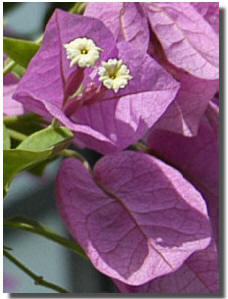Shirley Lindsey
Adams County Master Gardener
 If vines were people, courage would be their outstanding characteristic. Faced with overcrowding on the ground, they just took off and started climbing. Plant scientists tell us that vines probably originated in tropical rain forests where they
developed means of climbing in order to reach the sun, avoid predators, or get to places where insects or birds could pollinate them.
If vines were people, courage would be their outstanding characteristic. Faced with overcrowding on the ground, they just took off and started climbing. Plant scientists tell us that vines probably originated in tropical rain forests where they
developed means of climbing in order to reach the sun, avoid predators, or get to places where insects or birds could pollinate them.
Vines serve many purposes. Evergreen vines are grown for a green background all year. One favorite for fall color (and this is native to this area of PA) is Virginia creeper. Another is Boston ivy. Or for lovely flowers, clematis will always be my
first choice. There are many varieties, and they are incredible easy to grow and care for. If you love hummingbirds, you can't miss with a trumpet vine. Plant it away from your house because they get quite large and heavy and can do damage.
Vines are great choices if you want a new home to look 'lived in' since shrubs and trees take awhile to make an impact. They also serve as a background for other plants. They can hide a utility area, although one should be careful not to plant too
close to air conditioners. A vine can also soften and enhance bare walls or chain link fences.
I love vines for small yards. You can go 'up' when you can't go 'out.' On the other hand, they are wonderful for defining your garden when you have a lot of space but want your garden to go only so far. A vine on an arbor can be an entrance to a
garden room. If you want shade from the hot summer sun, plant a vine on the west or south side of a porch or deck. You can enjoy protection from the sun as well as the beauty of the vine.
Vines add color and life to deck posts, lamp posts and mailboxes. There are many ways to provide for climbers. Arbors are often lovely additions to the garden by themselves. You can use a vine pole as a climbing support. Even a building wall and
various kinds of fencing will serve you well as a good support.
American gardeners are sometimes accused by the English of being "flat" gardeners. That is, we don't use enough vines. However, as soon as we plant a vine and see what a delightful addition to the garden it is, we are likely to be hooked.
|

Bougainvillea glabra
|
And speaking of hooked, there are a number of different ways that vines climb. Climbing roses, as well as the southern beauty, Bougainvillea, climb by means of their thorns. Some vines need a helping hand to get them started. Tie them to a trellis or
other support until they get going. Still others such as English ivy or trumpet vine have "holdfasts" or little rootlets that come out at intervals and grab onto whatever is available. Another method used by vines to climb is to wrap itself around wire or wood or whatever
is available. Morning glory, clematis and wisteria are examples of this type of climbing. Still other vines such as sweet pea, bottle gourd and porcelain vine send out little tendrils that wrap around the support.
The clematis vine is a personal favorite of mine. It blooms year after year with minimal care. The large flowered types come in many colors and are especially beautiful when you plant two together and watch the colors intertwine. There are many small
flowered clematis that are just as lovely, but often have smaller bell-shaped flowers. One that is especially easy to grow is the sweet autumn clematis. It has clusters of very small white flowers with a slight fragrance.
Wisteria is a popular vine. It needs a sturdy support to climb on. There are lavender as well as white varieties. This plant will give your garden a delightfully romantic look. Be advised that it may take 2 or 3 years before it blooms, but it is well
worth waiting for.
Another popular perennial vine is the trumpet vine. This may not bloom for the first couple of years either; but if you want to attract hummingbirds, there is no better way. They are especially adapted to get nectar from the deep blooms of the
trumpet vine. And the blossoms themselves are a stunning orange-red. Yellow is available, too.
Vines also come in annual varieties. Some that will grow and bloom in a very short time are hyacinth bean (lavender flowers), scarlet runner bean (bright red flowers), morning glory (variety of colors), black-eyed Susan vine (this has orange-yellow
flowers with dark brown centers). These are all very easy to grow and a good choice in the event that you are not sure if you want to go with perennial vines.
Vines are a great way to get your garden "looking up." Unfortunately, there are some vines that you may want to take care to keep out of the garden. Several species of vines have escaped from plantings and/or the seeds have been spread by birds.
Avoid planting Celastrus orbiculatus (Oriental bittersweet) and Lonicera japonica (Japanese honeysuckle). In the southeast part of Pennsylvania they are beginning to find a problem with Akebia quinata (Fiveleaf akebia) and Ampelopsis brevipedunculata (Porcelain-berry).
Most of us have seen Helix hedera (English ivy) climbing up and choking out large trees. This doesn't mean we should never use it but just be sure that you, and not the ivy, are in charge of its spread.
There are also some invasive vines that come uninvited to our gardens: mile-a-minute, poison ivy and wild rose are just a few. One thing we can do to avoid planting invasive plants is to be sure to use plants native to this part of the world. Try
native honeysuckle and native bittersweet.
Vines are attractive additions to any garden. So pluck up your own courage this year and plant a few in your landscape-you won't regret it.
Read other articles on shrubs and vines
Read other articles by Shirley Lindsey